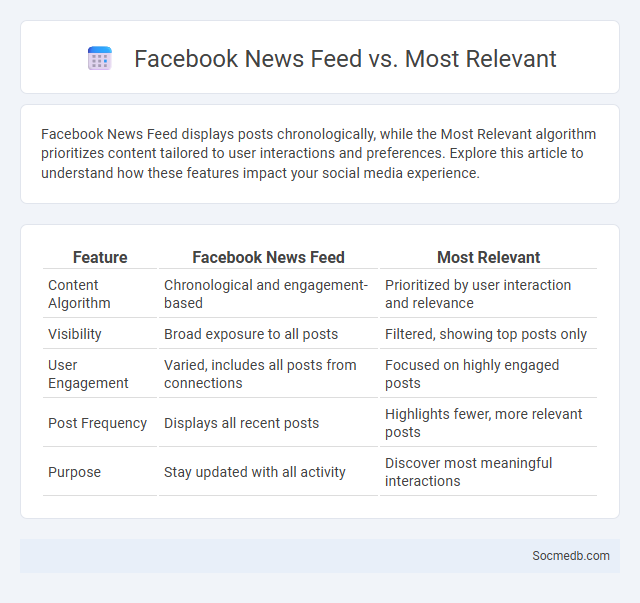
Photo illustration: Facebook News Feed vs Most Relevant
Facebook News Feed displays posts chronologically, while the Most Relevant algorithm prioritizes content tailored to user interactions and preferences. Explore this article to understand how these features impact your social media experience.
Table of Comparison
| Feature | Facebook News Feed | Most Relevant |
|---|---|---|
| Content Algorithm | Chronological and engagement-based | Prioritized by user interaction and relevance |
| Visibility | Broad exposure to all posts | Filtered, showing top posts only |
| User Engagement | Varied, includes all posts from connections | Focused on highly engaged posts |
| Post Frequency | Displays all recent posts | Highlights fewer, more relevant posts |
| Purpose | Stay updated with all activity | Discover most meaningful interactions |
Understanding Facebook News Feed Algorithm
Facebook News Feed Algorithm ranks posts based on user engagement metrics such as likes, comments, shares, and time spent on content, prioritizing highly relevant and personalized information for each user. The algorithm employs machine learning models to analyze user behavior patterns, predicting the likelihood of interaction with specific posts to enhance content relevance. Key factors influencing ranking include content type preferences, recency, and relationship strength between users, which collectively shape the dynamic and personalized nature of the News Feed experience.
What is “Most Relevant” on Facebook?
Facebook's "Most Relevant" feature prioritizes content in users' news feeds based on an algorithm analyzing engagement metrics such as likes, comments, shares, and user interactions. This relevance scoring incorporates factors like the relationship between the user and the content creator, post type, and timeliness to surface posts tailored to individual interests. Understanding this algorithm helps marketers optimize content strategy by focusing on engagement-driven posts and audience targeting to increase visibility.
Differences Between News Feed and Most Relevant
The News Feed on social media platforms displays posts in chronological order or based on recent activity, ensuring you see the latest updates from your connections. The Most Relevant feed uses algorithms to prioritize content that matches your interests, interactions, and preferences, showing posts likely to engage you the most. Understanding these differences helps optimize your social media experience by balancing timeliness with personalized relevance.
How Facebook Prioritizes Content
Facebook prioritizes content using a sophisticated algorithm that evaluates user engagement metrics such as likes, comments, and shares to determine relevancy. The algorithm also considers user preferences, post type, recency, and relationships between users to customize each news feed. Machine learning models analyze behavioral data to continually refine content ranking, enhancing user experience by promoting meaningful interactions.
User Control Over News Feed vs Most Relevant
User control over news feeds empowers individuals to customize content visibility, enhancing personal engagement and satisfaction. Algorithms promoting the most relevant posts prioritize content based on user behavior, increasing interaction but potentially limiting diverse perspectives. Balancing user-driven customization with algorithmic relevance is key to optimizing social media experiences and mitigating echo chamber effects.
Impact on User Engagement and Experience
Social media platforms significantly enhance user engagement by offering personalized content, interactive features, and real-time communication that keep users actively involved. Your experience is shaped by algorithms that curate relevant posts, while features like live streaming, stories, and reactions foster deeper connections and immediate feedback. These elements create immersive environments that boost attention, satisfaction, and the overall value of social media interactions.
Customizing Your Facebook News Preferences
Customizing your Facebook News Preferences allows you to control the content that appears in your feed, prioritizing posts from friends, pages, and groups you care about most. Adjusting these settings can enhance your user experience by filtering out unwanted content and highlighting relevant updates, promotions, or news articles. Your Facebook algorithm uses these preferences to tailor your News Feed, making your social media interactions more personalized and engaging.
Pros and Cons of Each Feed Option
Social media feed options include chronological, algorithmic, and hybrid feeds, each with distinct pros and cons. Chronological feeds offer real-time updates, ensuring you see posts in the order they were shared, but may overwhelm you with content. Algorithmic feeds prioritize relevance by analyzing your interactions, enhancing engagement but potentially creating echo chambers that limit diverse perspectives. Hybrid feeds combine both approaches to balance freshness and personalization, yet they might confuse users about why certain posts appear.
Practical Tips for Managing Facebook Feeds
Curate your Facebook feed by unfollowing pages and friends that do not add value to your daily updates to reduce clutter and improve content relevance. Utilize Facebook's "See First" feature to prioritize posts from your closest friends, favorite groups, and trusted news sources, ensuring that your feed reflects your interests and priorities. Consistently engage with meaningful content by liking, commenting, and sharing, which signals the algorithm to show more of what matters most to you.
Future Trends in Facebook Content Delivery
Facebook content delivery is evolving with AI-driven personalization and augmented reality features enhancing user engagement. Predictive algorithms will increasingly tailor Your newsfeed to prioritize relevant content, while interactive formats like AR stories will dominate. Expect seamless integration of e-commerce and social interaction to redefine how Facebook connects people and brands.
 socmedb.com
socmedb.com